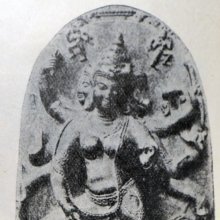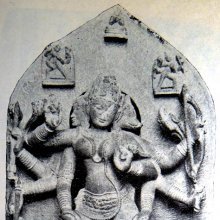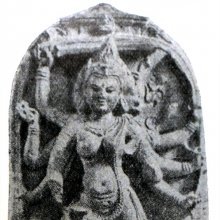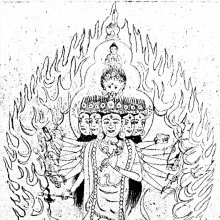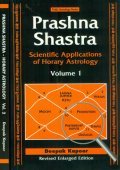Cavity: 3 definitions
Introduction:
Cavity means something in Hinduism, Sanskrit. If you want to know the exact meaning, history, etymology or English translation of this term then check out the descriptions on this page. Add your comment or reference to a book if you want to contribute to this summary article.
Images (photo gallery)
In Hinduism
Natyashastra (theatrics and dramaturgy)
Source: Shodhganga: Elements of Art and Architecture in the Trtiyakhanda of the Visnudharmottarapurana (natya)1) A Cavity (made by folding and joining the open hands together) is denoted by the Sanskrit term Añjali, whereas Añjalīhasta refers to one of the thirteen Combined-hand Gestures (in Indian Dramas) (known as saṃyuktahastas), according to the Viṣṇudharmottarapurāṇa, an ancient Sanskrit text which (being encyclopedic in nature) deals with a variety of cultural topics such as arts, architecture, music, grammar and astronomy.—The word añjali denotes a cavity made by folding and joining the open hands together or the hollow of the hands. According to the Viṣṇudharmottarapurāṇa, añjalīhasta is a combination of patākahasta which is used in the salutation of gods, teachers and ancestors. The Abhinayadarpaṇa also gives its view point in the same way.
2) Cavities are also denoted by the Sanskrit term Puṭa, whereas Puṣpahasta refers to another one of the thirteen Combined-hand Gestures.—The word puṣpapuṭa is made with two words viz., puṣpa means flower and puṭa i.e., cavity. According to the Viṣṇudharmottarapurāṇa, in puṣpapuṭa posture, both hands are joined together by their sides and the fingers of both hands should be in sarpaśīrṣa position.

Natyashastra (नाट्यशास्त्र, nāṭyaśāstra) refers to both the ancient Indian tradition (shastra) of performing arts, (natya—theatrics, drama, dance, music), as well as the name of a Sanskrit work dealing with these subjects. It also teaches the rules for composing Dramatic plays (nataka), construction and performance of Theater, and Poetic works (kavya).
Vastushastra (architecture)
Source: Shodhganga: Elements of Art and Architecture in the Trtiyakhanda of the Visnudharmottarapurana (vastu)Cavities represents an undesirable characteristic of those Stone that are to be used as a Material for the Construction of Temples, according to the Viṣṇudharmottarapurāṇa, an ancient Sanskrit text which (being encyclopedic in nature) deals with a variety of cultural topics such as arts, architecture, music, grammar and astronomy.—Finding of proper types of materials is one of the important aspects for any construction. Indian scriptures state that to procure the stones, the astrologer and the architect should go to mountain and examine the stones. The Viṣṇudharmottarapurāṇa specifies that some stones which are [e.g., ruined by cavities, etc.] are to be totally abandoned. [...] So, it can be said that in the Viṣṇudharmottarapurāṇa, the collection of materials for the construction of temple does not suggest any process that harms others.

Vastushastra (वास्तुशास्त्र, vāstuśāstra) refers to the ancient Indian science (shastra) of architecture (vastu), dealing with topics such architecture, sculpture, town-building, fort building and various other constructions. Vastu also deals with the philosophy of the architectural relation with the cosmic universe.
Yoga (school of philosophy)
Source: ORA: Amanaska (king of all yogas): A Critical Edition and Annotated Translation by Jason BirchCavities (i.e., the nasopharyngeal cavity) are denoted by the Sanskrit term Vivara, according to the Haṭhapradīpikā 4.100 (Cf. Uttaragīta 41cd-42, Maṇḍalabrāhmaṇopaniṣat 2.5.4-5, Gheraṇḍasaṃhitā 5.82-83ab).—Accordingly, “Because the [nasopharyngeal] cavity (vivara) above the uvula has been sealed by Khecarī Mudrā, the [Yogin’s] semen is not emitted [even when he] has been embraced by a beautiful woman. So long as his semen remains in his body, then why [would there be] fear of death?”.

Yoga is originally considered a branch of Hindu philosophy (astika), but both ancient and modern Yoga combine the physical, mental and spiritual. Yoga teaches various physical techniques also known as āsanas (postures), used for various purposes (eg., meditation, contemplation, relaxation).
See also (Relevant definitions)
Full-text (+679): Kakundara, Kuhara, Kukshi, Kotara, Anjali, Nabhika, Anjaliputa, Asthisara, Kukundara, Kholaga, Dholi, Puta, Pithagarbha, Palem, Khonga, Vivara, Putaka, Nadivrana, Khancakhavala, Randhra.
Relevant text
Search found 136 books and stories containing Cavity; (plurals include: Cavities). You can also click to the full overview containing English textual excerpts. Below are direct links for the most relevant articles:
The Sacrifices of Rajasuya, Vajapeya and Ashvamedha (study) (by Aparna Dhar)
Brief description of three fire cavities or Agni-kuṇḍa < [Chapter 2 - Vedic Sacrifices described in the Śatapatha Brāhmaṇa]
Śrauta and Gṛhya Karma < [Chapter 2 - Vedic Sacrifices described in the Śatapatha Brāhmaṇa]
Significance of Sacrifice < [Chapter 2 - Vedic Sacrifices described in the Śatapatha Brāhmaṇa]
The Skanda Purana (by G. V. Tagare)
Chapter 16 - Origin of Sunandā and Other Mother Goddesses < [Section 1 - Prabhāsa-kṣetra-māhātmya]
Chapter 50 - Departure of the Soul to the Next World < [Section 2 - Kaumārikā-khaṇḍa]
Chapter 45 - The Efficacy of Kumudvati < [Section 1 - Avantīkṣetra-māhātmya]
Manusmriti with the Commentary of Medhatithi (by Ganganatha Jha)
Verse 5.130 < [Section XIII - Purification of Substances]
Verse 4.144 < [Section XIV - Other Duties]
Verse 5.136 < [Section XIII - Purification of Substances]
Sushruta Samhita, Volume 6: Uttara-tantra (by Kaviraj Kunja Lal Bhishagratna)
Chapter XX - Causes and symptoms of Ear-disease < [Canto I - Shalakya-tantra (ears, eyes, nose, mouth and throat)]
Chapter XXI - Medical Treatment of Ear-disease < [Canto I - Shalakya-tantra (ears, eyes, nose, mouth and throat)]
Chapter XVIII - Preparations and medicinal measures for ocular affections in general < [Canto I - Shalakya-tantra (ears, eyes, nose, mouth and throat)]
The Garuda Purana (by Manmatha Nath Dutt)
Chapter CLXXXIX - The Nidanam of traumatic ulcers etc < [Dhanvantari Samhita]
Chapter CCXXII - The Garuda Vidya < [Dhanvantari Samhita]
Chapter CLXI - The Nidanam of Ascited etc < [Dhanvantari Samhita]
Yoga Vasistha [English], Volume 1-4 (by Vihari-Lala Mitra)
Chapter VIII - Song of the siddhas or holy adepts < [Book V - Upasama khanda (upashama khanda)]
Chapter LXXVIII - Manner of conducting the yoga hypnotism < [Book V - Upasama khanda (upashama khanda)]
Chapter L - On sensation and the objects of senses < [Book VI - Nirvana prakarana part 1 (nirvana prakarana)]
Related products
(+1 more products available)

